Doctors or Devils: Finding a Clinic in Japan
Top Photo: valelopardo on Pixabay
It’s every traveler’s worst nightmare: you’ve finally made it to that place you’ve always wanted to get to. Whether it be a short trip or the beginning of a much longer stay, you’re finally there. And then, it happens: you don’t feel well.
And it’s bad enough to the point that a Band-Aid or Tylenol won’t do the trick. You have to go see a doctor. But the bigger hospitals have stopped taking walk-ins for the day & require reservations. So that means you’re either in for a visit with the gentleman on the left, or the guy on the right:


But fear not! For as long as you have an idea of what to expect, visiting a smaller clinic (クリニック) in Japan as not really as imposing as it may seem.
When I first came to Japan, I obviously did not have my insurance squared away yet, and I woke up one day with blood in my eye! It’s safe to say I panicked and cried, thinking I was about to go blind.
The fact that I was alone in a hotel room in Japan during the early days of the Covid-19 pandemic made it so much worse. I immediately searched for “blood in my eye” and at least Google didn’t tell me I was about to lose my sight. I managed to find an English-speaking optometrist in Umeda, Osaka who allowed me to visit him without insurance or an advanced reservation.
Many doctors in the bigger cities will speak English or at least make an effort to try some form of English. And they are often, in my experience, kind to foreigners, which makes the visit much easier. I found my doctor with a simple Google search, called to inquire if English-speaking was possible, and if I could drop in on short notice. There was a form to fill out with simple details about my life and daily habits (all in Japanese). I paid about ¥5000 for the visit since I was uninsured, and he reassured me that the blood would slowly go away in the next week.
Recently, I have also been visiting a dentist to have some work done.
I suddenly got a toothache that lasted about 4 days. One Saturday morning it was so intense that I just had to visit a dentist. Upon researching dentists in Japan, I found to my dismay that they tend to close early on Saturdays. A co-worker of mine told me that usually dentists also speak English, but the reviews online said otherwise.
Once again, I looked up dentists in my area and learned there are 2 things I looked for: 1. Ratings and 2. English-speaking ability. As I mentioned before, most dental offices are closed by midday on Saturdays, but I managed to find one about 45 minutes from where I live that speaks English (YAY!) and stayed open quite late. I called to confirm and a Japanese speaker answered, who then gave the phone to an English speaker who turned out to be the dentist himself.
Upon my arrival, they checked my temperature and I had to fill out one of those forms again. Japanese dental procedures are quite different from where I come from. I am normally terrified of dentists, but in Japan it’s relaxing and pain-free. It could just be this specific dentist, but he was gentle and quite patient with all my questions. Turns out I needed a root canal! In the time since, my dentist has always been very attentive and careful not to cause me any pain. If I feel the slightest twinge, he always says sorry.
All in all, when you need to visit any clinic, Google is your best friend. Things to remember: check ratings, reviews and always call to inquire and confirm. I know calling might be a bit scary if you don’t speak Japanese, but they can’t see you over the phone so really there is no cause for embarrassment. When visiting, make sure to carry your insurance card, if you have one, or else you will have to pay the full sum. If the forms are in full Japanese and you are having difficulty, don’t worry! The staff will help you fill it out.
I know the title implied that the doctors here can be devils, but really, it’s quite the opposite. I am ever so grateful for the kindness I have experienced so far. Typically, people are afraid of doctors because of the pain factor, but rest assured you are in good hands if you ever need to visit a doctor while in Japan. They are amazing at what they do and will definitely take care of you. Thanks for reading!
Photo Credits:
Top Photo: valelopardo on Pixabay
Additional images provided by Irasutoya
All other content (text) created by the original author and © 2020 MUSUBI by Borderlink
Top Photo: “Mt. Ōyama seen from Mt. Sannotō, Kanagawa, Japan” by Σ64, licensed under the Creative Commons Attribution-Share Alike 3.0 Unported license. (cc-by-SA-3.0). No changes or alterations were made. Wikimedia Commons Link

The majestic Mount Oyama (Kanagawa)
While Tokyo and other large cities in Japan have their charms, over time you may desire to escape the drab greyness of the concrete jungle and head for the fresh air, exercise, and green colors of the countryside. In Kanagawa, in around one hour from Tokyo, you can find a natural getaway at Mt. Oyama, offering refreshing mountain air, various hiking trails and cultural points of interest.
The easiest way to reach Mt. Oyama is by taking the Odakyu train line to Isehara station, taking just under an hour from Shinjuku. Then you can take a frequent bus for a 25 minute ride to the trailhead at Oyama Cable Car bus stop. From there, you make your way through the historical Koma Sando, a narrow mountain walkway selling traditional wooden toys, fresh vegetables, tofu dishes, dango snacks and more.
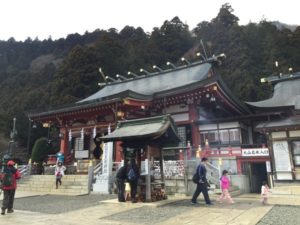
Afuri Shrine – photo by Andrew Rouse
If you are feeling lazy, you can take the recently redesigned cable car to whisk you up to the colorful Afuri Shrine around halfway up the mountain. From there you can see a beautiful view of the surrounding mountains, cities and Shonan beach in the distance.
Under the shrine you can find a dark walkway leading to an underground natural spring where you can refill your water bottle from the mouth of a dragon sculpture, and next you’ll see Shinto and Buddhist statues lit by candlelight.
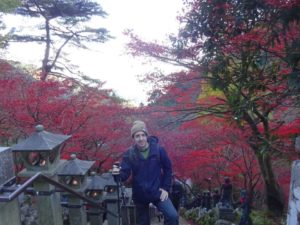
Oyama Temple – photo of author
It takes another hour and a half to reach the summit at 1,252m, but on the way you can enjoy views of small waterfalls and Mt. Fuji on a clear day. There are various routes up the mountain, but for beginners I recommend the main route mentioned above. There are more intermediate level hikes on the east and west sides for those who want a challenge. Also check out the Buddhist Oyama Temple a short walk below the Afuri Shrine, where you can walk down a long stairway surrounded by awe-inspiring guardian statues.
Autumn is probably the best time to visit Mt. Oyama, and you can enjoy the splendid colors of the autumn foliage. Summertime is often just too hot to climb the mountain comfortably. Humid temperatures bring out pesky mountain leeches, so if visiting at that time you’ll want to bring a bag of salt or deterrent spray (another reason to schedule your trip for the cooler months). Also, be sure to bring ample water, a hat, proper footwear, a map and an emergency light if hiking in the late afternoon.
Consider Mt. Oyama as an introduction to the wonders of the beautiful Japanese mountains and countryside. Beyond Mt. Oyama, after getting your legs up to speed, you can enjoy even greater sights in the higher mountains such as the Japan Alps of Yamanashi and Nagano prefectures.
Photo Credits:
Top Photo: “Mt. Ōyama seen from Mt. Sannotō, Kanagawa, Japan” by Σ64, licensed under the Creative Commons Attribution-Share Alike 3.0 Unported license. (cc-by-SA-3.0). No changes or alterations were made. Wikimedia Commons Link
Additional photos provided by Andrew Rouse and used with permission
All other content (text) created by the original author and © 2020 MUSUBI by Borderlink
Do you remember school lunch as a kid? Did you jump for joy when it was time to receive your rectangular slice of pizza? Did you loathe tuna salad day? Well reminisce no longer, for if you decide to become an Assistant Language Teacher at a public school in Japan, you shall be inducted into the glorious world of kyushoku (給食), or Japanese school lunch.
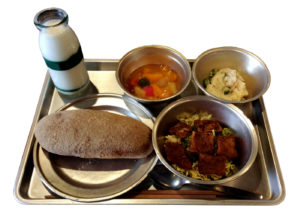
Metal dishes, glass milk bottles and bread are often associated with Showa-era school lunches. Photo Credit: Project Kei (CC BY-SA 4.0) Wikimedia Commons Link
School lunches are common around the world, but Japan’s system is without a doubt one-of-a-kind. The nationwide school lunch program began in the 1950’s and has remained a fixture of nearly all elementary and most junior high schools ever since. Over the decades school lunches have evolved and diversified, although many of the principles have remained the same. Here’s a brief introduction to the joys of school lunch in Japan!
A Balanced & Varied Menu
Usually, a typical kyushoku is made up of a starch dish (commonly rice, bread or noodles), a soup (such as miso or minestrone), a vegetable dish, a meat dish, and milk to drink. There are many variations on this template, with dishes sometimes combined (for example, with pork curry or meat sauce spaghetti). Desserts also pop up from time to time, though tend to lean towards healthier fare like fresh fruit or yogurt. Even the milk may occasionally be changed up with chocolate or strawberry-flavoring powder.
The goal of school lunches is multifold; not only do they provide children with a balanced, healthy meal, but they promote acceptance of variety. Students are encouraged to try new foods, as Japanese staples are often mixed with those of other countries, and of course “cleaning your plate” is expected. The absence of choice- students at most schools are required to have the school lunch throughout their elementary years- actually works to promote less picky eating habits.
It also provides a balancer for children from different economic backgrounds, as everyone eats the same food. Enough is made each morning to ensure that everyone gets at least one portion of every dish. In the case of junior high schools, where students are growing more rapidly, usually enough is prepared for seconds for those who want or need them.
Made Fresh, Healthy and & Cost-Efficient
Speaking of preparation, school lunches are made daily, either at a school lunch center or the schools themselves if they’re equipped with the facilities. Many of the ingredients are fresh and come from local farmers through agreements with the city.
The nutrition of young students is taken very seriously in Japan, and the lunches that are prepared reflect that. Lunch plans and composition are designed ahead of time by the school nutritionist, and each portion is constructed with a certain amount of caloric intake in mind, ensuring that the school lunch you eat every day is part of a perfectly balanced diet. The average lunch costs roughly 250 yen, or $2.33, an unbelievable bargain for a delicious, well-balanced meal.
An Important Part of School Life
Kyushoku is not only delicious, but it is an important part of the day for students socially as well. Every day, lunchtime roles are designated; students may go downstairs to pick up the classes’ portions in containers or on carts.
They then serve the lunch to the rest of the class- if you’re ever invited to attend lunch at a school, be prepared to be patient as eating doesn’t begin until everyone has been served.
Some smaller schools do have a communal lunch area where the Sts will go to eat outside of their class rooms, but the responsibilities remain. Lunch is typically the main time of the day (besides short breaks between classes and recess) where students are able to converse freely.
Depending upon the school, even the teachers will sit with the students in their assigned lunch groups or in the cafeteria (depending on size of school and which system they wish to use) and converse with them. These conversations over meals about non-school related topics help to deepen bonds between students and teachers. The current climate of social distancing has hampered this somewhat (it’s more common for teachers, including ALTs, to eat in the staff room) this tradition will no doubt return once it becomes safer to do so.
In Conclusion
Lest you get the wrong idea, you don’t have to participate in school lunch. While it is expected of the students and staff to partake in it, concessions have to be made for those with dietary restrictions. This includes teachers. For ALTs who prefer a vegetarian, vegan or other type of diet, the school lunches may not always be tailored to your tastes (you can always opt out of one or two items if you have particular allergies or religious reasons).
However, if you don’t have issues with any foods, then it’s highly recommended that you participate in receiving school lunch. Not only because of the many positive attributes I’ve described above, but also because the entire school body joining in eating the school lunch that was prepared for them that day is culturally important and an experience worth partaking in. Fresh, delicious, nutritious, inexpensive meals. What more could one ask for? Kyushoku is most certainly high up on the list of perks for being an ALT in Japan. I highly recommend trying it!
For more information on how you can enjoy school lunches & much more in Japan, read about the job of an ALT and how you can experience Japan!
Photo Credits:
1 – Project Kei licensed under the Creative Commons Attribution-Share Alike 4.0 International license. Wikimedia Commons Link
All other content (text) created by the original author and © 2020 MUSUBI by Borderlink
What’s the best way to see Japan? You’re likely to get any number of answers to that one- on foot, by car, by train, by Shinkansen- but one other popular (and healthy!) way to get it done is by bicycle.
Have Bike, Will Ride
If you’re like me and can’t drive, a bike will be one of your greatest assets to have in Japan. For day-to-day tasks such as to making your grocery run, going to work, getting to the station, etc. few things top a good ‘ol bike.
Regarding types of bikes, you have some choices: the mama chari (ママチャリ) a kind of simple bike with a basket in the front and no gears often associated with moms; the hybrid bike- not exactly a mountain or road bike, but you have some gears and the look is more sporty- and finally, the specialized bikes (mountain bikes, road bikes, etc.). Whichever you choose is really up to you.
Getting a Bike! And Then Registering It
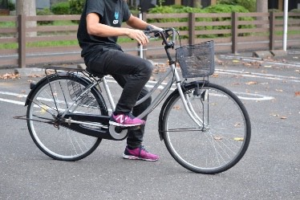
Let’s get ready to ride!
Getting a bike will depend a bit on which kind of bike you wish to have. If you wish to buy a mama chari, you can go mostly anywhere to get one, and they are pretty cheap (sometimes less than even ¥10,000). They can do the job if you don’t have much hill to climb, and you can find them in most bike shops, home centers (renovation centers), sport shops as well as online or in recycle shops/used goods shops.
If you want a hybrid bike or specialized bike, you will need to spend much more and go to bike-specific specialized shops. Some regular sport shops or bike shops might have few models. Also, be aware that if you are 170 cm or taller, it might be difficult to find a frame of your size.
Once you have your bike, it is strongly recommended to register it at your local police office. By doing so, your bike will get a sticker with a number on it, like a license plate for a car. This is mostly in case your bike get stolen (always be sure to lock it), or if you are not careful and park it somewhere forbidden (and it gets taken to the tow yard). It’s with this number that the officials will be able to confirm that it’s your bike. So get registered!
Riding Your Bike, Japanese-Style
In Japan, if you ride a bike you must abide by the circulation rules. Which in short, are mostly the same as driving a car with a few key differences. The max speed allowed is 25 km/h (15.53 mph). Also, using your headlamp is a requirement at night. Police officers are pretty strict about that, especially in autumn when it starts getting darker earlier and many students fail to do it.
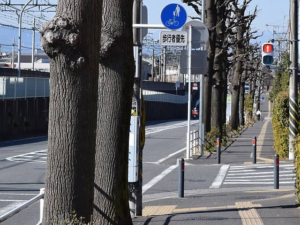
Street or sidewalk? Choose carefully when biking.
You are generally allowed to ride on the sidewalk and most people prefer to do so rather than ride on the street. If you ride on the street, be aware the some streets are forbidden to bike (highways, bypasses and some other heavy traffic roads).
Since most Japanese ride on the sidewalk, car drivers are not really good at sharing the street with you. But know that if you ride on the sidewalk, you MUST be careful of pedestrians- fines for injuring someone with a bike can be severe, so always exercise extreme caution and know when to slow down. Please be careful!
You will sometimes notice that riding against traffic is a common thing. It’s common, but technically not allowed. Riding with two people on the same bike to is forbidden (even if you saw it in manga and anime) and students are often caught doing so. Most younger folks get away with a mild scolding, but don’t expect that kind of leniency as an adult.
You will also notice the difference between the “real” bike riders and everyone else. One of the biggest hints is the saddle height. Most people keep their saddle to the lowest level. It makes it hard to pedal, but easier to keep balance. Since most people go really slow (you could walk beside them) keeping balance is a must. Also, I think it’s really just a fashion thing. The “real” one will have a hybrid or specialized bike, their saddle will be at good height, and they’ll ride on the street, often at max speed. Which type of biker you want to be is up to you!
Bike Parking Lots & Shared Bike Services
And now, a little word on bike parking lots. You will notice them mostly around train stations, and most of them are wide open spaces where you can park your bike for free. Be aware though that in big cities, the parking lots closest to the station might be for monthly renters only or charged by the day. If you park your bike in one of those, never forget to lock it! When we talk about locking it, it’s not about locking it to a fence or something, but to just lock the wheels to the frame (front and back) is enough. The mama chari usually already have a lock installed on the back wheel.

The magnificence of Shimanami Kaido!
More and more cities offer a bike-sharing service or bike rental. You can find those bikes mostly around train stations, shopping malls and tourist attractions. Shared bikes cost around ¥100 per hour, but again it depends on the city. Bike rental services work per day, half day or per hour. The fees really depend on the renting service. The big difference between the two is that the shared bikes are parked at automated terminal spaces (like a coin locker) and you leave it at any of the terminals, while rental bikes need to be procured at a shop or counter and brought back to that same counter after use (note that some shops are part of a network, so you can leave it at any partner shop).
One final note: Japan also has numerous beautiful cycling roads, like the Shimanami Kaido that goes from Onomichi to Imabari. The starting points of those cycling roads are often accessible by train or bus and usually have a bike rental service close by. So even if you live in Tokyo, you don’t have to bring your bike down to Onomichi to enjoy the Shimanami Kaido.
So there you have it. Ride carefully and enjoy the roads of Japan! Maybe we’ll cross paths on the bike trail some day!
Photo Credits:
Additional photos provided by Mona Baker
All other content (text) created by the original author and © 2020 MUSUBI by Borderlink
Top photo: jarmoluk on Pixabay
Before coming to Japan, we often imagine what our lives would be like in this new country. We have visions of going on exotic trips, trying new foods, meeting interesting people, and possibly even settling down and starting a family. Japan seems like a far-off dreamland of sights and sounds, colors and wonders. For those who spend a couple days or weeks here on a vacation, it may end up being just that!
For many who have decided to live and work here though, our projected vision and current reality do not always link up. We find ourselves coming home from work tired, only interacting with our work colleagues on work-related issues, and not having an opportunity to speak with anyone from the outside world except through social media.
While some are content with this frequency of communication, others have become disenchanted by their experience living in an isolated situation. Where are the people that we were supposed to befriend? Where are the events that we were supposed to participate in? Where were the opportunities we were supposed to seize?
If finding friends and opportunities are becoming a bit difficult, a great way to get them is by living in a share house! In contrast to living alone in an apartment complex, share house living affords one a very different kind of experience based around socialization. Here are some great benefits for this uniquely Japanese living experience.
Accommodations

A typical 1LDK apartment

A typical share house room
Share houses are rental places with private accommodations and shared communal spaces. When we envision communal living, we dread the lack of privacy dormitories have to offer. But share houses offer a variety of living accommodations. It’s a feeling that brings you back to your college days, but not all the way back. No snoring roommates anymore!

A share house communal area for dining, etc.
There are rental places that have private rooms with private bathrooms or private kitchens and shared living spaces. Shared spaces can be kitchens, lounges, movie theaters, gyms, and social office spaces. You can live in a more social residence or a quiet two story house.
Just like apartment living, share house living has a wide variety of styles that can suit your needs. In general, your private room in a share house will be smaller than most apartments. But it will be cozy, and the communal rooms more than make up the space difference!
Events/ Activities
Share houses can provide you with organized events and activities. There are many cultural events that are hosted by share house companies. For example, Oakhouse has an annual sports day festival where houses compete for trophies. They have a summer camp event at a river for all of their houses.
There are also organized fitness challenges where residents can get rent discounts for weight loss. If organized events aren’t your thing, residents can also host small get-togethers in lounges or share a meal with friends.
Diversify your group of friends!
You can improve your Japanese or learn a new language while living in a share house. There are many people from different countries who live in share houses, but the majority of their residents are Japanese. So why not take up the opportunity to befriend some interesting people. Share house living can give you many opportunities to make long-lasting friendships.
As adults, we are indoctrinated into believing that living on our own as a sign of accomplishment and maturity, but in a way that has limited us from much-needed social interaction.
I suggest that upon entering Japan, try living in a share house. It will get you acclimated into Japanese culture and give you an opportunity to make friends and keep friends when you decide to move out on your own.
Many ALTs enjoy share house living too! What’s an ALT? Well you can read all about it here, and here’s how you can experience Japan for yourself!
Photo Credits:
Top photo: jarmoluk on Pixabay
Additional photos provided by Terita Lewin.
All other content (text) created by the original author and © 2020 MUSUBI by Borderlink
Winter is coming, but are you ready? Like much of the northern hemisphere, seasonal influenza is an annual occurrence throughout Japan from November through April. What makes the Fall/Winter 2020 version different is the ongoing COVID-19 pandemic. With people already exercising additional caution to avoid spreading one virus, it’s easy to think chances of catching the flu will decrease this year. Hopefully, that’s the case.
Whatever happens, it’s always good to be prepared, and the following tips are useful every year, whether you’re in Japan or around the world. So here’s our top 4 ways to stay healthy over these next few months.
Get the Annual Flu Shot
 Getting the yearly flu vaccination is a great way to help bolster your defenses against infection. It’s fast, easy, and relatively inexpensive in Japan. The vaccine is not mandatory under the Ministry of Health’s policies, so you will need to sign up and pay for it separately (this also applies for children if you are also getting them vaccinated). The easiest way to get a flu shot ASAP is at your local clinic; larger hospitals tend to only offer it on designated days.
Getting the yearly flu vaccination is a great way to help bolster your defenses against infection. It’s fast, easy, and relatively inexpensive in Japan. The vaccine is not mandatory under the Ministry of Health’s policies, so you will need to sign up and pay for it separately (this also applies for children if you are also getting them vaccinated). The easiest way to get a flu shot ASAP is at your local clinic; larger hospitals tend to only offer it on designated days.
At the clinic, fill in the necessary paperwork (a special booth or counter may be set up for it). Note that the clinic may have a set time period during the day when they administer the shot, and also have temporarily limited quantities of the vaccination (until more stock arrives). While some clinics let you just walk in and just receive it, others may require reservation in advance.
Remember that the flu vaccine is good for a year, so you will need to receive another dose annually. Side effects are minimal, but it is good to be aware in advance. For more information getting vaccinated, see the Ministry of Health’s guide.
Exercise Caution & Common Sense
 After months of life under the coronavirus, exercising common sense should hopefully be a facet of everyday life for most. Wear masks, try to minimize direct contact with others, and frequent hand washing/gargling are all musts. As influenza can enter easily through the eyes, avoid rubbing your eyes directly with your hands; carrying pocket tissues at all times is highly recommended.
After months of life under the coronavirus, exercising common sense should hopefully be a facet of everyday life for most. Wear masks, try to minimize direct contact with others, and frequent hand washing/gargling are all musts. As influenza can enter easily through the eyes, avoid rubbing your eyes directly with your hands; carrying pocket tissues at all times is highly recommended.
Given the current climate of precaution, it may be easier than usual to avoid getting common colds or influenza, but it’s best to remain vigilant; both will still be spreading around in the coming months, regardless of new developments in the fight against COVID-19.
Eat Flu-Fighting Foods
 You are what you eat, and eating healthy foods can help boost your immune system, making you less susceptible to infection. Some foods you can add to your diet to increase immunity include carrots, eggs, Kiwi fruits, almonds, kale, ginger, mushrooms, garlic, pumpkin seeds, and that old favorite, chicken soup.
You are what you eat, and eating healthy foods can help boost your immune system, making you less susceptible to infection. Some foods you can add to your diet to increase immunity include carrots, eggs, Kiwi fruits, almonds, kale, ginger, mushrooms, garlic, pumpkin seeds, and that old favorite, chicken soup.
In general, hot drinks are a great early way to deter illness. Drinking something hot with lemon or honey in it is highly recommended during the initial stages (especially if you have a sore throat) and can sometimes work to lessen the impact of the common cold. Additionally, drink plenty of water.
Know the Warning Signs
 In the event you do start feeling under the weather, familiarize yourself with the initial symptoms of influenza to know whether or not it really is the flu or simply the common cold.
In the event you do start feeling under the weather, familiarize yourself with the initial symptoms of influenza to know whether or not it really is the flu or simply the common cold.
Generally, the latter begins with a sore throat, escalating into a cough, runny nose, and bouts of sneezing. Initial flu symptoms are usually (but not limited to) headache, fevers over 38°C, and fatigue. Generally, fevers for colds are lower than for influenza.
Once you have determined it’s more than a cold, the big question is whether it’s seasonal influenza or COVID-19. A few symptoms present with COVID-19 infection that are generally not typical of the flu include shortness of breath or difficulty breathing, repeated shaking with chills, and sudden loss of taste or smell. At this stage, getting tested ASAP is the best way to determine what comes next. If you do have the flu, you may be prescribed medication and asked to self-quarantine.
Ultimately, as with any medical matter, the best thing you can do is to stay informed and educated. And you can do that right now! We hope you’ll stay safe and healthy over these coming months, and start 2021 off at your best!
Photo Credits:
Additional photos provided by Irasutoya
All other content (text) created by the original author and © 2020 MUSUBI by Borderlink
Top Image: RightCowLeftCoast licensed under the Creative Commons Attribution-Share Alike 4.0 International license. Wikimedia Commons Link
Ah Ramen. That wonderful and affordable steamy bowl of sustenance is well loved nationwide. Actually, it’s the one dish I cannot live without. To my whole family, this bowl of wonders will never go out of style. Whether it be winter, spring, fall, or even summer, we all partake in a hot bowl of wheat noodles and flavorful broth. Ramen is a heavenly creation to die for, as my youngest puts it.
Most of my boys have lived in Japan their whole life, and this basin of deliciousness has long been a regular staple on our table. And why not? It’s easy to prepare and contains a lot of healthy benefits. To one of my son’s surprise, this favorite dish of his originally came from China! He recently found out while eating at a ramen shop a few blocks from our house in Kani.
Said ramen shop is arguably, one of the best ramen shops in our city: Ramen Ichibanken. While it is a franchise with stores across the country (originating in Nagoya), the Ichibanken in Kani, Gifu is extra-special to us. When we want to have a pleasant family meal, it’s our go-to place.
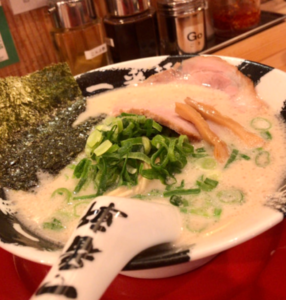 Located 1.1 miles away from Imawatari station, Ramen Ichibanken is the place to go when you need your ramen fix. A quick Siri search told me that there are 29 ramen shops located within 2 mile radius from my place. That is a lot of places to get ramen!
Located 1.1 miles away from Imawatari station, Ramen Ichibanken is the place to go when you need your ramen fix. A quick Siri search told me that there are 29 ramen shops located within 2 mile radius from my place. That is a lot of places to get ramen!
But Ichibanken is special, maybe because the atmosphere is so cozy and accommodating; the feeling of a family meal perhaps. Or maybe it’s just the awesome taste of the food: rich, right and perfect. Either way, it’s a favorite hotspot of Kani locals.
For most, it’s the ramen soup that divides opinions the sharpest. Shōyu or Miso? Tonkotsu or Shio? Everyone has their favorite. For me, in any bowl of ramen, it’s the noodles that make or break the whole dish. Few things are less satisfying than subpar noodles.
Ichibanken does not disappoint. The noodles taste like they’re made daily, if my taste buds aren’t deceiving me. The ingredients are definitely fresh and flawless in quality. Not to be forgotten, the soup tastes heavenly. Ichibanken’s specialty is Tonkotsu (pork bone broth) and it is as thick and hearty as it gets. What more could you ask for, really?
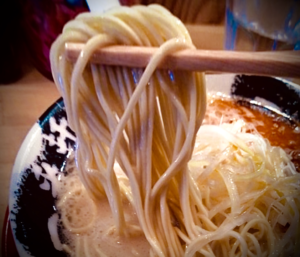 Not only that, but Ichibanken’s side dishes bring the whole meal together in perfect harmony. Gyoza, fried rice, marinated pork and karaage (Japanese-style fried chicken) make for some of the great sides. The servings are big enough to satisfy, but they’re also an affordable specially to a very budget-conscious person like me.
Not only that, but Ichibanken’s side dishes bring the whole meal together in perfect harmony. Gyoza, fried rice, marinated pork and karaage (Japanese-style fried chicken) make for some of the great sides. The servings are big enough to satisfy, but they’re also an affordable specially to a very budget-conscious person like me.
As mentioned, locals frequent this place all the time, and even those just passing through feel the allure. The tastes keep them coming back for more, just as they will you if you ever find yourself hungry and in Gifu. Whenever the mood for some ramen strikes you, this place is impeccable. Definitely worth a visit!
Photo Credits:
Top Image: RightCowLeftCoast licensed under the Creative Commons Attribution-Share Alike 4.0 International license. Wikimedia Commons Link
Additional photos were provided by Joseph Cerezo, used with permission.
All other content (text) created by the original author and © 2020 MUSUBI by Borderlink
Top photo: StockSnap on Pixabay
Okay, I might have oversimplified in the title. Sure, I’ve broken it down into 5 steps, but I never said the steps were going to be easy! Still, if you’re here, you probably want to learn Japanese. Why? Does your family or a loved one speak it? Do you want to move to or visit Japan? Are you fascinated by the culture? Are you just simply tired of gaijin-smashing your way through life in Japan? Whatever your “why,” learning any language is no simple task, and I apologize if I misled you. This will take time, effort, and occasional instances of trial-and-error.
With that said, here are my 5 steps (of varying ease) to help set you on the path towards becoming a more natural speaker of Nihongo!
Step 1: Find Your “Why?”
If you read the first paragraph, you’ve already started this journey. The first step in learning any language is knowing why. Why is that so important? Because learning a language is a lot of work and if you want to see this through to the end, you will need a lot of motivation to get you through the pits of despair. It can sometimes feel like a hopeless task, but if you remember your goal, you are more likely to keep moving.
Step 2: Pick Your Learning Material
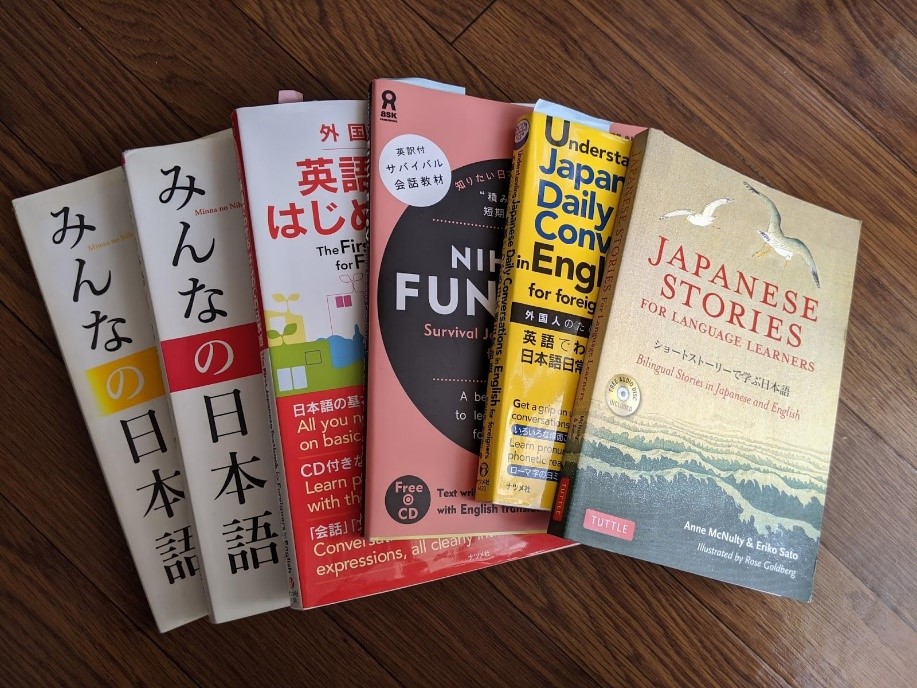
A small sample of my personal collection of textbooks and study aides.
Now that you have the motivation, you need the means. You need to find your primary sources of learning. There are so many resources to choose from. You can go the traditional route and buy a textbook. They are well-organized and usually simple to follow. They might even come with exercises and evaluation systems.
If you’re a little pickier about what you want to learn, or already know your path, there are also plenty of blogs and websites that will teach you the materials. They often focus on one particular aspect of language at a time, and I find some sources do certain things better than others. For grammar, I love Bunpro because it can be organized to follow your textbook, the JLPT system or just study at random. The grammar explanations are pretty basic, but they offer links to several sites that provide more in-depth explanations.
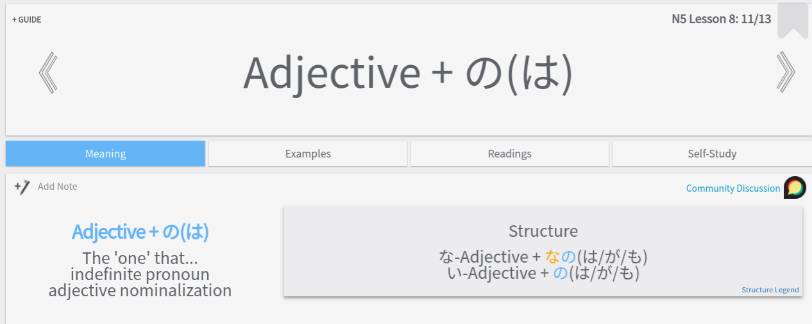
An example of suggested and related material from Bunpro.
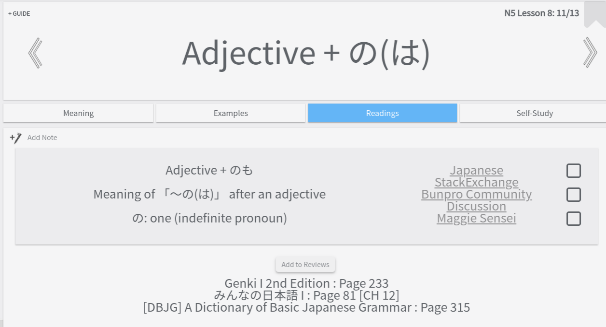
An example of related material from Bunpro.
Learning hiragana and katakana are an absolute must for studying Japanese. You won’t find very many books (or language schools for that matter) that use only romaji. Luckily, there are lots of app games you can use to learn these. But learning kanji is a different story. It is one of the biggest obstacles to becoming literate in Japanese and is one of the scariest things for those of us that only know the Latin/Roman alphabet.
But if you can break down the kanji into their building blocks, you will see patterns. This is exactly what WaniKani does, and they’ll give you fun mnemonics to help learn the readings. They also give you vocabulary using the kanji you learn and example sentences. The one downfall of WaniKani is that they don’t give you much explanation of nuance, so I have used formal styles of words in casual settings and vice versa. I recommend using a dictionary too.
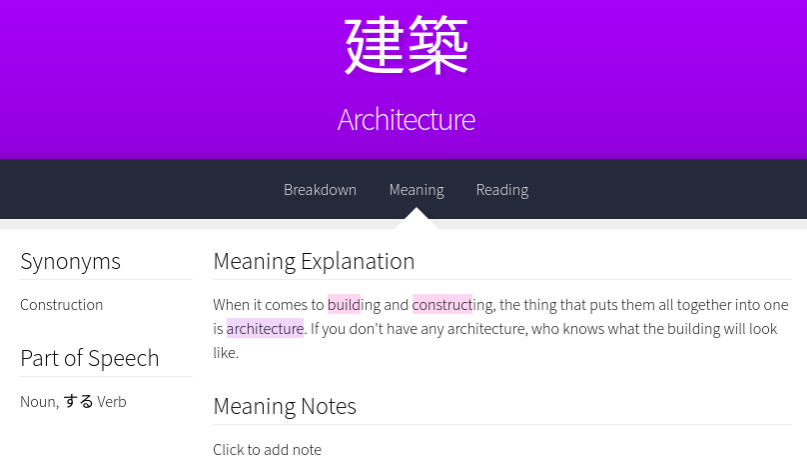
An example of vocabulary learning on WaniKani.
Step 3: Review & Review Often
Unless you have a photographic memory, chances are you will not remember it all just by reading. You need methods of reviewing and committing that information to memory. That’s why I like Bunpro and WaniKani. They both use Spaced Repetition System (SRS) to quiz you on the materials you learn. The more you answer it correctly, the less often you see it in your review queue.
However, there are far too many vocabulary systems that utilize SRS to pick one that stands out. Find your favorite and stick with it. Preferably, find one with an alarm that reminds you to do your reviews. I had to build my reviews into my daily schedule because I keep forgetting to do them otherwise.
Step 4: Practice Conversation

Sample notes from a conversation class
Studying at home is great when you’re learning something new and mastering the basics, but it is practically worthless compared to what you get from speaking. Speaking is the high-stakes all-or-nothing application of everything you learn. But if you’re self-studying, it is the hardest thing to do. Fear not! There are solutions!
Thanks to the internet, we have language-exchange options. There are so many different apps that offer different things, but most will connect you with people who speak the language you are learning and are learning the language you speak. You chat with these people (via messages, video, voice, or even in person), usually in a 50/50 split, so that you both pay and are paid for the time by speaking practice. Pretty nice.
If you want someone a little more trained in language instruction, or want 100% Japanese, you can always attend classes. You can pay for classes via personal tutor, organization or online. The options are much more plentiful for those already living in Japan, but especially in the age of Covid, you can find many Japanese conversation classes online.
The cheapest option, and my personal favorite, are the community-run conversation classes, but they’re usually a Japan-only specialty. Often, your city office will provide information about international services, especially if you make it clear to them that you are not Japanese. Or a quick google search will reveal something. These classes are small and led by volunteers with a little training, so it is an easier and slower level than what you might find in the wild and more tailored to your needs.
What I really love about these classes is that because they are a community service, you can ask the teacher to help you with anything, as long as the other one or two students don’t mind. I bring questions about grammar and vocabulary, get writing corrections and more, which are all services that would otherwise cost a lot through an institution.
Skills like reading and writing should also be practiced, but I find that reading and writing kanji falls more into the review stage. These are solo tasks and get applied to the language you learn, thus, learning to compose your thoughts quickly in Japanese will help your communication skills in the written medium.
Step 5: Speak Japanese
Once you get more comfortable speaking in a classroom setting, you can start bringing your Japanese into the real world (although you don’t have to wait). Say no to the plastic bag at the register. Ask for help at a store. Compliment your Japanese friend’s new shoes. These simple interactions build a lot of confidence and the responses you get are real-world, not simplified-for-your-level-in-the-classroom Japanese.
It’ll help if you take notes about what you experience in these situations. They used a word you don’t know? Go look it up. See the kanji for a word you already know? Try to recognize it in other places too. Things I learn this way are always a lot easier to remember because they have experiences attached. The mind is a funny thing.
There is a secret sixth step too: repeat. Really, steps two through five are meant to be used with each and every bit of Japanese you learn. Study a new grammar point, kanji or vocabulary word, review it and then use it. That’s how you build up your ability.
This guide may sound a bit vague, and it is, but that’s because we all learn in different ways. I could tell you exactly how I study, but you aren’t going to follow the same study path as me. Find what works for you and set small goals. If you can look back and see the progress you’ve made, it’ll make the journey forward a lot more enjoyable.
がんばってください!
Resources suggested:
BunPro https://www.bunpro.jp/
TaeKim http://www.guidetojapanese.org/learn/
WaniKani https://www.wanikani.com/
Tokyo Area Free Japanese classes https://www.japanswitch.com/guide-to-free-japanese-lessons-in-tokyo/
Photo Credits:
Top photo: StockSnap on Pixabay
Additional photos provided by Maya McDonald, used with permission
All other content (text) created by the original author and © 2020 MUSUBI by Borderlink
